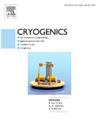Effect of hole pattern on high temperature superconducting wire using metal stitching for high-speed quench propagation
IF 2.1
3区 工程技术
Q3 PHYSICS, APPLIED
引用次数: 0
Abstract
In this study, we investigated the influence of hole pattern on the quench propagation behavior of high-temperature superconducting (HTS) wires utilizing a metal stitching technique. A nano-second laser processing system was used to fabricate precise micro-hole patterns through the metal and insulation layers of the HTS conductor. To evaluate the quench performance, HTS wires were prepared with various hole spacing patterns (5 cm, 2.5 cm, and 1 cm) and compared with an unmodified original wire. The results showed that as the hole spacing decreased, the decay of the central magnetic field after quench became significantly faster. In particular, the sample with 2.5 cm spacing exhibited a sharp drop in central field from 44 G to 3 G after quench. Additionally, a metal-insulated coil incorporating a 2 cm-spacing metal stitching pattern demonstrated a magnetic flux density decay rate exceeding 40 G/sec, indicating improved responsiveness in quench detection and protection systems. These findings confirm the potential of metal stitching as a structural strategy to enhance the quench safety in HTS applications.
孔型对金属拼接高温超导线高速淬火传播的影响
在本研究中,我们利用金属拼接技术研究了孔模式对高温超导导线淬火传播行为的影响。利用纳秒激光加工系统在高温超导导体的金属层和绝缘层上加工出精密的微孔图案。为了评估淬火性能,制备了不同孔间距模式(5厘米,2.5厘米和1厘米)的高温超导丝,并与未修改的原始丝进行了比较。结果表明:随着孔间距的减小,淬火后的中心磁场衰减速度明显加快;特别是2.5 cm的试样,淬火后中心磁场从44 G急剧下降到3 G。此外,采用2厘米间距金属拼接模式的金属绝缘线圈显示出超过40 G/sec的磁通密度衰减率,表明淬灭检测和保护系统的响应性得到改善。这些发现证实了金属拼接作为一种结构策略的潜力,以提高高温超导应用中的淬火安全性。
本文章由计算机程序翻译,如有差异,请以英文原文为准。
求助全文
约1分钟内获得全文
求助全文
来源期刊

Cryogenics
物理-热力学
CiteScore
3.80
自引率
9.50%
发文量
0
审稿时长
2.1 months
期刊介绍:
Cryogenics is the world''s leading journal focusing on all aspects of cryoengineering and cryogenics. Papers published in Cryogenics cover a wide variety of subjects in low temperature engineering and research. Among the areas covered are:
- Applications of superconductivity: magnets, electronics, devices
- Superconductors and their properties
- Properties of materials: metals, alloys, composites, polymers, insulations
- New applications of cryogenic technology to processes, devices, machinery
- Refrigeration and liquefaction technology
- Thermodynamics
- Fluid properties and fluid mechanics
- Heat transfer
- Thermometry and measurement science
- Cryogenics in medicine
- Cryoelectronics
 求助内容:
求助内容: 应助结果提醒方式:
应助结果提醒方式:


